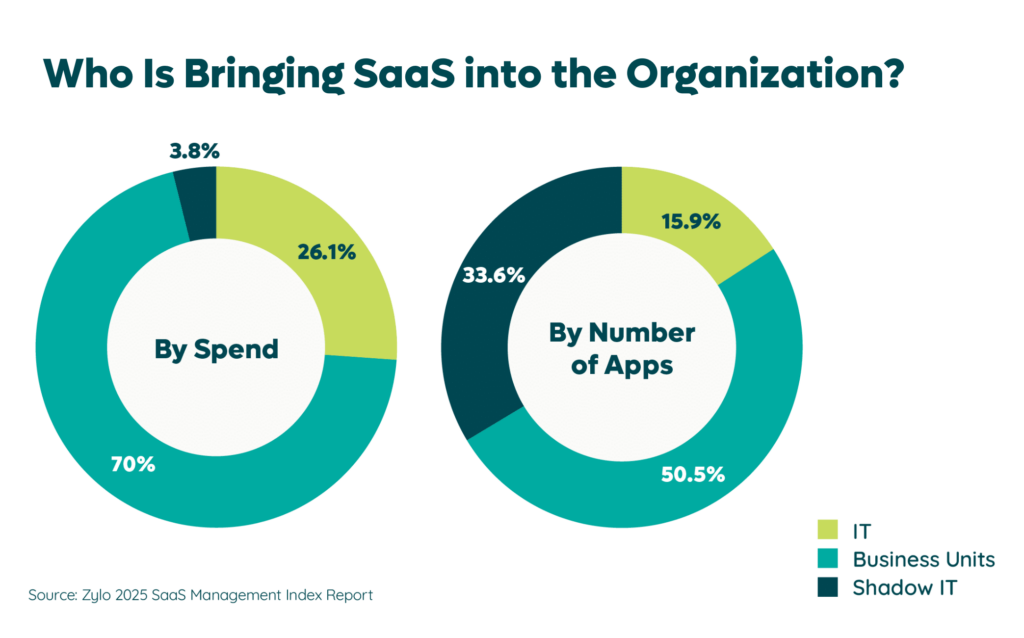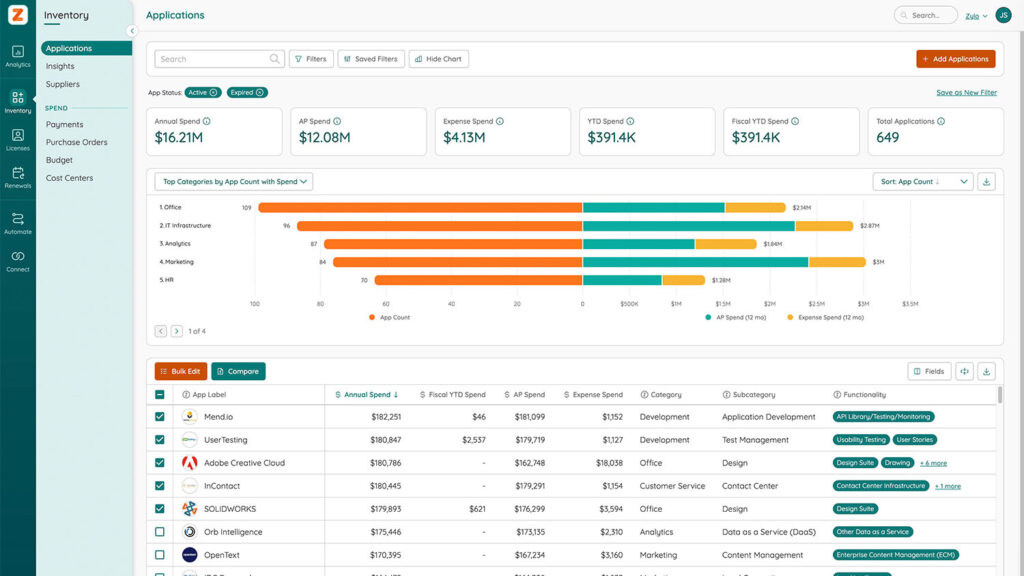
Zoom License Cost 2026: Which Plan Offers the Best Value for Your…
Table of Contents ToggleWhy Democratize Tech BudgetingReducing Tech Budget Control Puts...
Back
Back
Search for Keywords...
Blog

Table of Contents
In the era of responsible business growth, there’s more pressure than ever to contain and reduce costs. With software often your second largest operating expense, this is a great place to start. But managing your tech budget isn’t easy. SaaS is subscription-based, and its inherent pricing and licensing variability make it difficult to accurately forecast.
In the past (with on-premises software), CIOs were the sole owners of software, because there were only a handful of titles across the business. With the proliferation of SaaS, managing tech budgets no longer rests solely on the CIO’s shoulders. Instead, we’ve entered a new era where accountability for technology spending is shared by departments.
While this shift may seem daunting, it presents an opportunity for CIOs to evolve into more strategic leadership roles, focusing on collaboration and innovation. This blog will explore the changing role of the CIO in managing the tech budget and why other departments need to be included as SaaS Management evolves.
CIOs are increasingly stepping into strategic leadership roles. In fact, “Thirty-five percent of respondents to the 2024 State of the CIO now identify as strategic CIOs with almost half (49%) expecting to play that role over the three-to-five-year horizon.”
Now, they’re starting to leave behind the granular, day-to-day oversight of individual tech decisions. One of those decisions is the budget. This doesn’t mean abandoning the tech budget entirely, but rather democratizing its management across the business.
The need to democratize tech budgeting is due in part to the large scale and sprawl of software in the business. Today, the average company has around 275 applications in its portfolio. Overseeing budgets for every tool is overwhelming and impractical—especially when certain apps are owned by business units that IT may not even be aware of.

While managing costs is still a priority, CIOs must navigate a complex balancing act. That means juggling innovation pressures with the need for operational excellence. In 2024, CIOs focused heavily on security, financial risk, and operational efficiency, with key priorities including:
The role of business units as primary buyers of software is also shifting the landscape. Today, IT departments manage just 26% of total SaaS spend and only 16% of applications – according to Zylo’s SaaS Management Index report. Compared to 2021, this represents a meager 3.2% decrease in SaaS spend but a substantial 30.8% decrease in the number of applications purchased by IT. Now, when business units purchase their own software, they are inherently responsible for it within their budget.

Shifting to a democratized, or shared, budgeting model for software offers a new opportunity for collaboration. CIOs can work cross-functionally with business units to break down barriers, optimize costs, and share the responsibility of managing tech investments across the organization.
Together, IT and business units, led by the CIO’s strategic vision, form a powerful alliance that drives more informed and effective business and technology decisions. As the CIO’s role evolves, so too must the approach to tech budgeting, with a stronger emphasis on strategy and shared accountability.
With rising tech spending, budgeting is no longer just an operational task. It’s a key strategic decision that impacts the entire organization. And for good reason: we’re all spending a lot on software.
Gartner predicts that end-user spending on SaaS will reach $299B in 2025, reflecting a 19.2% increase from 2024. This increase in spending highlights the need for thoughtful and strategic oversight of technology investments.
Failing to address the financial risk associated with software spending can lead to overspending, wasted resources, and inefficient purchasing processes. It’s crucial that every budget owner, from IT to business units, understands the impact of their spending decisions.
 What does that actually mean for your business? Unused licenses alone account for an average of $21M in wasted spend annually ($127.3M for large enterprises). Redundant applications and multiple channel spending—such as the average of 23 applications purchased through accounts payable and expense channels—only add to the inefficiency.
What does that actually mean for your business? Unused licenses alone account for an average of $21M in wasted spend annually ($127.3M for large enterprises). Redundant applications and multiple channel spending—such as the average of 23 applications purchased through accounts payable and expense channels—only add to the inefficiency.
Budget owners must be able to see costs and be held accountable for adhering to and optimizing software budgets. Organizations can better align their tech investments with strategic goals by ensuring everyone involved in purchasing decisions has a clear view of financial risks and opportunities. This shared responsibility fosters a more collaborative and cost-efficient approach to managing technology across the business.
Guide to Managing SaaS Costs
Learn MoreA collaborative approach to tech budgeting is essential, and using a SaaS Management Platform makes this process significantly easier.
As CIOs evolve into more strategic leaders, decentralized software purchasing shifts the responsibility for budget ownership and accountability to line of business (LOB) leaders. At the same time, CIOs must maintain oversight, stay informed about how to deploy technology investments, and play an advisory role in key decisions.
According to the 2024 State of CIO report, “CIOs continue to gain stature as a strategic advisor to the business, with three-quarters of IT leaders and 78% of LOB respondents confirming CIOs have increased visibility within the larger organization.”
Responding to their growing responsibilities, many CIOs have prioritized strong partnerships with other leaders across their organizations. Cultivating these relationships is essential for optimizing decision-making and ensuring IT functions as a true business partner.
Take the CFO for instance. CIOs must also build strong partnerships with CFOs to drive effective change management from a budget perspective. Doing so ensures that both IT and finance leaders align on purchasing strategies and manage financial risks together.
By working closely with LOB leaders, CIOs can help guide technology investments while ensuring that they align with broader business goals.
Bringing in other functional areas to be part of the conversation is critical, according to fractional CFO Chris Ortega. “[SaaS] is one of the biggest opportunities CFOs have to make an immediate cashflow impact in their business. And it’s traditionally not the first place that people go…. Having transparency, visibility, collaboration, and overall connection to a strategy is where you really see finance teams partnering inside the business, making this successful.”
Getting the right people at the table is step one. To be effective collaborators and make informed decisions, data is critical – and a SaaS Management Platform is key to centralizing this data for all stakeholders.
By consolidating information on app usage, spending, contracts, and utilization, an SMP helps CIOs and business units make strategic choices regarding enterprise architecture, security, and spend management.

When CIOs become strategic partners, they have a direct hand in approving SaaS purchases and selecting vendors. Regular communication with department leaders is critical, especially when the shared goals include improving ROI, aligning tools with business needs, and enhancing SaaS efficiency.
CIOs and CFOs, for example, work toward the same objectives—CIOs focus on optimizing the tech stack, while CFOs aim to control costs. When these leaders collaborate, they can achieve more effective outcomes for the business.
A financial investment in software doesn’t always equate to measurable value. In many cases, value extends beyond tangible ROI and can be challenging to quantify. That’s why it is essential to focus on the outcomes a tool is delivering for your business. If the tool isn’t delivering as expected, the data within your SaaS Management Platform (SMP) can guide decisions on optimizing your portfolio—whether for renewals, rationalization, or addressing license waste.
Nick Mehta, CEO of Gainsight, breaks down value into three critical categories:
By centering discussions around these three dimensions of value, you can better assess the true impact of your software investments and make more informed decisions in the future.
As IT continues to elevate its role as a strategic business partner, it is being seen more as a value driver than a cost center. According to the 2024 State of CIO report, the IT organization is more business driven with heavy focus on:
In addition, taking control of the tech budget is another way CIOs are driving value within the business. This is especially important, as costs continue to rise and CIOs continue to feel the pinch. In fact, 54% of CIOs expect their budgets to increase, with an average 17% hike in 2024, up from 15% over the past two years.
Today, CIOs must embrace a collaborative and strategic approach to managing SaaS investments. By leveraging a comprehensive SaaS Management Platform like Zylo, IT can transform from a cost center into a key driver of business value. Now, IT can:
If you’re ready to take control of your SaaS budget and reap the benefits, tour the platform to see it in action!

Table of Contents ToggleWhy Democratize Tech BudgetingReducing Tech Budget Control Puts...

Table of Contents ToggleWhy Democratize Tech BudgetingReducing Tech Budget Control Puts...

Table of Contents ToggleKey Themes That Shaped SaaS Management in 20251....

Table of Contents ToggleWhy Democratize Tech BudgetingReducing Tech Budget Control Puts...
| Cookie | Duration | Description |
|---|---|---|
| cookielawinfo-checkbox-analytics | 11 months | This cookie is set by GDPR Cookie Consent plugin. The cookie is used to store the user consent for the cookies in the category "Analytics". |
| cookielawinfo-checkbox-functional | 11 months | The cookie is set by GDPR cookie consent to record the user consent for the cookies in the category "Functional". |
| cookielawinfo-checkbox-necessary | 11 months | This cookie is set by GDPR Cookie Consent plugin. The cookies is used to store the user consent for the cookies in the category "Necessary". |
| cookielawinfo-checkbox-others | 11 months | This cookie is set by GDPR Cookie Consent plugin. The cookie is used to store the user consent for the cookies in the category "Other. |
| cookielawinfo-checkbox-performance | 11 months | This cookie is set by GDPR Cookie Consent plugin. The cookie is used to store the user consent for the cookies in the category "Performance". |
| viewed_cookie_policy | 11 months | The cookie is set by the GDPR Cookie Consent plugin and is used to store whether or not user has consented to the use of cookies. It does not store any personal data. |
